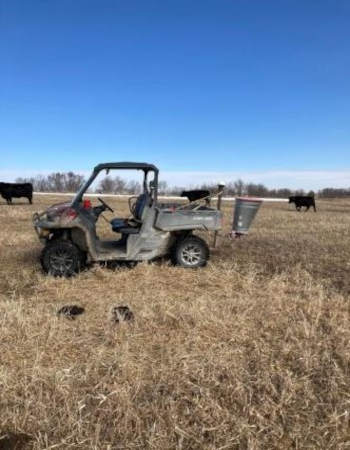By Joshua Michel and Rebecca Vittetoe
Many pastures in Iowa were stressed in 2020 from the dry conditions, storm damage, or overgrazing. Consider improving pasture stands and forage production with either frost seeding or interseeding this spring. Proper planning and preparation are needed to successfully improve pastures, and this ICM Blog “Still Time to Start Prepping for Pasture Renovations in 2021” addresses what should be done prior to any frost seeding or interseeding.
Additonally, below are some guidelines to consider in order to optimize the success of frost seeding or interseeding.

Frost seeding at the ISU McNay Research Farm.
Frost seeding
Frost seeding involves spreading forage seed on existing pastures during the late winter or very early spring while the ground is still frozen. Freeze-thaw cycles then provide shallow coverage of the seed, which help shield the seeds from early spring rains. Frost seeding is the easiest method to add new forage legumes to pastures, and is likely the least expensive method, as well. To increase this method's success, spread seed on the thinnest pasture sod areas first and on areas where bare soil has been exposed due to heavy grazing or disturbance.
The goal of frost seeding is to get the seed in contact with bare soil. For this reason, frost seeding on top of snow cover should be avoided. If snow accumulates after you’ve frost seeded on bare ground, that is perfectly fine.
Red clover has been the Iowa forage species of choice for frost seeding because of its quick establishment, small seed size and ability to grow in a variety of soil and environmental conditions. Other legumes, such as white clover, alsike clover, and birdsfoot trefoil, also can be frost seeded but with less success than red clover. In general, frost seeding does not work as well with many types of grasses, primarily due to the large seed size not working through the soil surface as easily.
A few well-researched steps will improve the success of frost seeding. Those steps, seeding rates and guidelines are available in the ISU Extension and Outreach publication Improving Pasture by Frost Seeding.
Interseeding
Interseeding involves using a few field operations to introduce additional forage species into an existing pasture stand. Interseeding is normally done from mid-March through early May when soil moisture and temperature are more suitable for rapid seedling establishment.
Interseeding can be accomplished with relatively few field operations. Opening of the grass sod, shallow seed placement, and seed coverage are required. While a number of drills are available for use in sod-seeding efforts, drills vary in their effectiveness based on their ability to penetrate sod, provide uniform seed depth and metering, and the ability to cover the furrow. Seed placement should be as shallow as possible while still maintaining firm soil over the seed. Equipment limitations for sod-seeding implements sometimes are overcome by operator experience and home shop modifications.
Clovers, alfalfa, and birdsfoot trefoil are legumes that have been successfully interseeded. Legumes interseeded into grass sod will help increase pasture yield, improve forage quality, and eliminate or minimize the need for nitrogen fertilizer. Due to more efficient seed placement, perennial forage grasses may also be successfully established by interseeding. A grass-legume mixture may be best if the present grass stand is thin, low-producing, or where a change in the proportion of grass to legume species is desired.
A seeding delay into late spring to improve growing conditions may often lead to greater competition from the existing grass sod. Close grazing in the fall or spring, ahead of interseeding, will help to reduce sod competition. Contact herbicides are sometimes also used to temporarily further reduce competition from plants present in the stand. Use only labeled herbicides for sod suppression and follow label instructions.
Success with interseeding depends a lot on paying attention to details, timeliness, careful management of sod competition, controlling seeding depth to no deeper than one-fourth to one-half inch, and a little bit of luck with weather.
See ISU Extension and Outreach publication Interseeding and No-Till Pasture Renovation for more suggested seeding rates and guidelines.
To help with the success of frost seeding or interseeding, it is important to give those new seedlings time to get established. Wait to start grazing until the new seedlings pass the pluck test. When grazing, consider reducing the stocking rate and don’t graze too closely. Mowing can also help the new seeding get well-established and to compete with the existing stand.
Source : iastate.edu